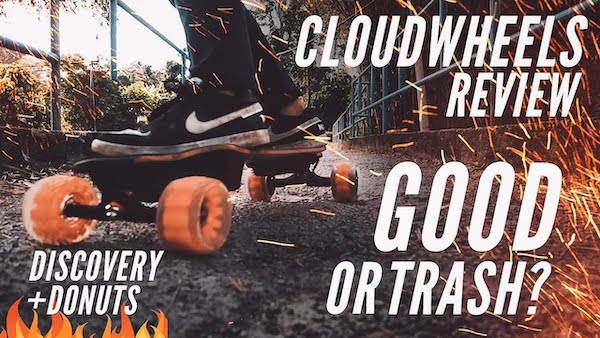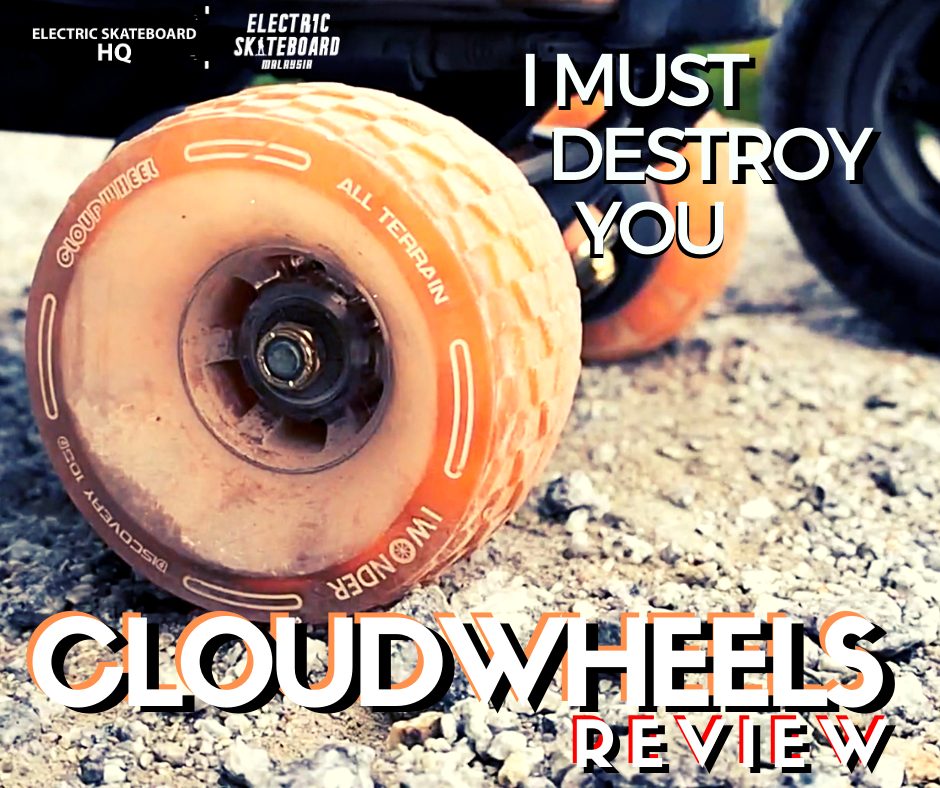Today we will be reviewing iWonder’s Cloudwheels Discovery and Cloudwheels Donuts.
(This is the updated version of the previous Cloudwheel review here)
These wheels became a showstopper in the eskate community. People are either top fans or serious haters for the Cloudwheels. So what is the real deal? Are these wheels as fancy as they say?
For those who don’t already know, Cloudwheels are $139-169 urban “off-road wheels,” that come in sizes 105mm and 120mm. A donut version is also available for hub boards. The wheels are marketed as all-terrain wheels, which is something that we might not be able to just take their words for.
So, what are the Cloudwheels?
Cloudwheel Discovery Wheels are built with urethane in a durometer of 78a. These babies are very soft because of their foam core. iWonder calls the technology Dampening Foam Core or DFC when they try to sound cooler, I call it “pretty bubbles inside the wheel.” Aside from the softness, the style also allowed a lighter weight as compared with your normal big urethane wheels.

A softer wheel should offer more grip, but it’s the opposite for Cloudwheels. This is due to the fact that Cloudwheel has a very narrow contact patch. iWonder didn’t provide a measurement for the contact patch, but it’s pretty obvious to the eye. The curved tread design means only the center of the wheel is in contact when riding on flat ground.

This gave a specific ride feel for Cloudwheels that not everyone became fond of. We will discuss more on the ride feel later.
Abit of scandal on the initial days of Cloudwheels:
Every product can use a little bit of scandal on launch, eh..?
Now, here are a few more things to note about the core. Back when it was launched, the first version of Cloudwheels used a regular ABEC core. This version seemed to crack for some riders.
To resolve this concern, iWonder used Nylon Fiberglass to reinforce the core and also made the spokes thicker. This design was named Discovery core.

Installing Cloudwheels
By the looks of it, the latest Discovery core might still look like an ABEC core, but it’s not! The Discovery core has a thicker spoke than the average ABEC wheels core. Your ABEC pulley might not fit the Cloudwheels.
However, the Cloudwheels pulley can still be used with your typical ABEC wheels, but there will be slop on the wheels, which means, it will be loose, and that’s not very nice (or safe).
No worries for the pulleys though, since Cloudwheel has made pulley kits for almost every eskate on the market. Cloudwheel has pulleys, if you have coins. (You can check the list of Cloudwheel supported boards by going here)
Now, let’s talk about Cloudwheel Donuts. For hub motor lovers, the Cloudwheel Donuts may just be the greatest thing since sliced bread. Cloudwheel Donuts are basically sleeves for your hub motors. It is not difficult to see where the name came from.

Donuts are compatible with a lot of hub motors but not all, so be sure to check the list of compatible hub motors first when buying Cloudwheel Donuts.
To check out other eskates compatible with Cloudwheel Donuts, click here.
It will take around 15 minutes to install these wheels, depending on how quickly you maneuver from unscrewing bolts to slide out the hub motor’s back wheels up to secure all the new screws for the Cloudwheels.

For a quick look on how to install Cloudwheel Donuts:
What an introduction, huh? Now let’s go to the part you’re all excited about—the pros and cons of Cloudwheels.
Like we mentioned, people are pretty divided on their opinions for Cloudwheels. They either love it or hate it.
Let’s begin with the good things about these wheels.
PROS
Safer and smoother ride
Obviously, the main advantage that the Cloudwheels can give is a safer and smoother ride.
We’ll say upfront that iWonder’s Cloudwheels are basically semi-AT. We would never even dare to call it all-terrain or made for off-road like how it was marketed. Still, the wheels provide significantly better cushioning on a roughly paved road. The ride won’t be as harsh for you.

Cloudwheels is probably most popular among eskate commuters who simply aim to travel from point A to B safely but consider the bulky AT set up to be a trouble for carrying around. Not to forget, Cloudwheels are a lot lighter than even the standard PU wheels of similar size.
Cloudwheels also help a lot in cushioning the ride though super rough roads, making some unbearable – leg-numbing road bearable. And obviously, big wheels means less lightly to get thrown off the board when hitting a stone.
Cloudwheels = All-terrain?
While the 105mm wheel will do enough to make rough pavement significantly more tolerable, the bigger 120mm is obviously better, and almost necessary when you plan to go off the standard path.
To handle grass, small cracks, and stone, the 105mm wheels are enough, but if you’re gonna go through sand and pebbled roads, a safer choice would be the 120mm wheels. BUT, if that’s the kind of terrain you’re gunning for, then you should probably go for AT wheels instead.

Pretty good Durability
Another surprise we have with Cloudwheels is their durability.
We rode the Cloudwheels for almost 200 miles and there was zero chunking. And nope, we weren’t careful at all! Also, regarding the new Discovery core? It held up without cracks too. Combining our experience and the fact that there aren’t any more complaints on the internet after the switch to Discovery core, we are pretty confident that the new Cloudwheel will be just fine.

Now, what are the not-so-nice thing about Cloudwheel?
CONS
Less fun with carving
As we said, you’ll get a less grippy ride with Cloudwheels due to its pretty narrow contact patch. Not to worry though, the narrow contact patch doesn’t actually cause the wheels to lose grip, so there aren’t actually any safety concerns.

It did mean that carving became a lot less fun, though, if you compare it with riding on street wheels. Simply put, carving on Cloudwheels will never be as fun as carving on Caguamas; but it’s still better than carving on 6” pneumatic wheels.
Next, let’s talk about the range.
Decrease range
As uncle Ben used to say, with great wheel size comes great battery consumption. The bigger the wheels, the lesser the range. However, the range drain wasn’t actually as significant when it came to Cloudwheels. This is probably the result of the narrow contact patch on the wheel, resulting in better use of energy.

If you do the math, our test showed us that going from 90mm hub motors to 105mm Cloudwheels gave a drop of 25% in range. We got 16.8 miles on 90mm wheels but when we started using 105mm Cloudwheels, we only got 12.4 miles. From a different perspective though, switching to the 120mm Cloudwheels will allow you to size down from all-terrain wheels and your range will significantly be better.
Now that we’re done with the rundown of specs, pros, and cons, what’s our verdict?
THE VERDICT
The Cloudwheel Donuts is hailed as the savior for hub boards, and it might not be an overstatement.
The biggest pet peeve that eskaters have on the hub boards is the thin urethane sleeves and hence agonizing vibration when riding on rough roads. Remarkably, Cloudwheel Donuts basically solved that problem. The 105mm wheels probably won’t open up new ride paths for you, but would make commuting much safer and more comfortable.
The verdict on the regular 105mm and 120mm Cloudwheels (for Belt drive) are pretty clear too. If you like big wheels for its safety, semi-AT use, and don’t mind the less grippy ride feel, you will love the Cloudwheels.
If a big wheel with a narrow contact patch is not your style, then you should already know that Cloudwheels is not for you. Eskate connoisseurs would probably prefer something like 107mm Super Flywheels or 110mm Torqueboard Wheels instead.
Basically, Cloudwheels are just very practical wheels, period.
If you are interested in buying the Cloudwheels, be sure to check out our affiliate discount link here and uses code: “ESKATEHQ” to receive $10 off during check out.
It will help you get a small monetary discount and helps us out too. On top of that, you’ll be tagged as an Electric Skateboard HQ customer and probably be treated better. Cheers!















